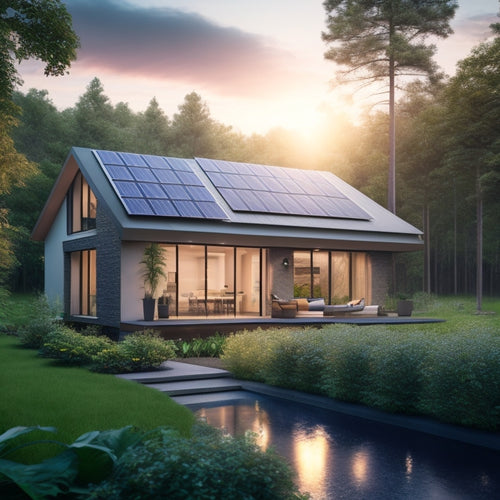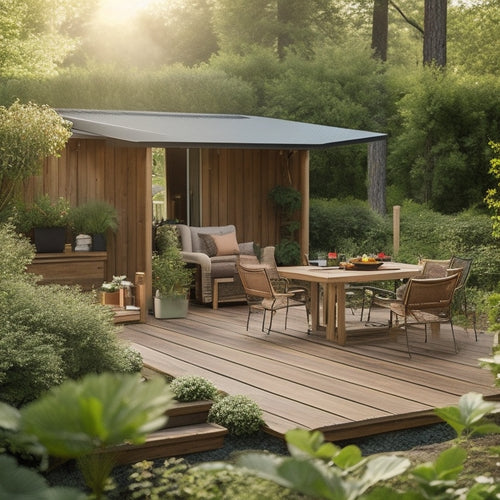
Solar Panel Safety: Essential Inspection Steps for Homeowners
Share
You take satisfaction in owning a solar panel system that generates clean energy, but it's vital to guarantee its safety and ideal performance through regular inspections and maintenance. Start with a visual inspection of your solar panels to identify signs of physical damage, wear, or deterioration, and verify secure fastening to the roof and condition of the mounting system. Next, inspect electrical connections for wear, damage, or corrosion, and confirm proper grounding to prevent electrical shocks and fires. Then, review your roof and mounting system, implement performance monitoring, and conduct regular maintenance and repairs. By following these essential steps, you'll be well on your way to maximizing your system's safety and efficiency, and uncovering more opportunities to enhance its performance.
Key Takeaways
- Inspect solar panels for physical damage, wear, or deterioration, checking for cracks, broken glass, and loose connections to prevent hazards.
- Verify secure fastening of panels to the roof and condition of the mounting system to ensure stability and prevent collapse.
- Check electrical connections for wear, damage, or corrosion, and confirm proper grounding to prevent electrical shocks and fires.
- Regularly clean solar panels to remove dirt and debris, ensuring optimal energy output and efficiency.
- Implement performance monitoring and analysis to track energy output, identify optimization opportunities, and receive alerts for performance deviations.
Visual Inspection of Solar Panels
When conducting a visual inspection of solar panels, your primary focus should be on identifying any signs of physical damage, wear, or deterioration that could compromise their performance or safety.
Check for cracks, broken glass, or loose connections that can lead to electrical shock or fire hazards. Verify that the panels are securely fastened to the roof and that the mounting system is in good condition.
Confirm panel cleanliness by looking for dirt, debris, or vegetation that may be obstructing sunlight.
Additionally, consider site assessment and installation considerations to guarantee peak energy output, and evaluate available space for installation, confirming compliance with local regulations.
Also, perform installation verification by checking that the panels are installed at the correct angle and direction to maximize energy output.
Electrical Connection Safety Check
Having verified the solar panels are physically intact and securely fastened, you can now shift your attention to the electrical connections that enable the flow of energy.
This critical step guarantees the safe and efficient transmission of power from your solar panels to your home. Regular inspection of electrical connections is essential for peak performance, as loose connections can lead to energy losses and fire hazards connection tightness.
To perform an electrical connection safety check, follow these essential steps:
-
Verify wiring integrity: Inspect the wiring for signs of wear, damage, or corrosion. Check for loose connections, frayed wires, or exposed copper.
-
Conduct grounding verification: Confirm that the system is properly grounded to prevent electrical shocks and fires. Check that all grounding points are secure and not damaged.
-
Inspect electrical connectors and terminals: Check that all electrical connectors and terminals are clean, secure, and free from corrosion or damage.
Roof and Mounting System Review
Beyond the electrical connections, your attention now turns to the roof and mounting system that supports your solar panels. You need to verify the roof structure can handle the weight and stress of the solar array.
Check for signs of wear, damage, or deterioration on the roof, paying attention to areas around the mounting points. Verify that the mounting materials, such as clamps, brackets, and fasteners, are secure and corrosion-free.
It's crucial to take into account the local climate conditions and assess the structural integrity of the installation to optimize energy production. Inspect the rails and tracks for straightness and levelness, and confirm that the panels are properly secured to the mounting system.
Any defects or weaknesses in the roof or mounting system can compromise the entire solar panel installation, so it's critical to identify and address any issues promptly.
Performance Monitoring and Analysis
Your solar panel system's performance is only as good as the data it provides, so it's vital to implement a strong performance monitoring and analysis system. This allows you to track your energy output and identify areas for improvement.
With a sturdy monitoring system, you can optimize energy usage, controlling consumption and minimizing costs and environmental impact hybrid approach. Regular maintenance, including cleaning, is essential for solar panel performance and energy efficiency.
With a sturdy monitoring system, you can:
-
Track energy output in real-time: Keep an eye on your system's performance and identify any anomalies or dips in production.
-
Analyze efficiency metrics: Monitor your system's efficiency and identify opportunities to optimize its performance.
-
Receive alerts and notifications: Get instant alerts when your system's performance deviates from expected levels, ensuring prompt action to address any issues.
Regular Maintenance and Repair
As your solar panel system operates, it's exposed to various environmental factors that can affect its performance, making regular maintenance and repair vital to guaranteeing ideal energy output.
Regular maintenance practices greatly influence battery longevity and can extend the lifespan of your solar battery by 5-15 years importance of maintenance.
You'll need to perform routine checks to identify potential issues before they escalate into major problems. Regular cleaning is essential, so develop effective cleaning techniques to remove dirt, debris, and other obstructions.
Be certain to inspect your system's electrical connections, mounting systems, and inverters for signs of wear or damage. Keep warranty considerations in mind when performing repairs, as improper maintenance can void your warranty.
Frequently Asked Questions
Can Solar Panels Cause Roof Leaks or Water Damage?
Like a ticking time bomb, a faulty solar panel installation can release a torrent of water damage, but you can defuse the threat by addressing installation concerns and following proper maintenance tips to guarantee a watertight seal.
Do Solar Panels Attract Lightning or Increase Lightning Risk?
You're right to wonder if solar panels attract lightning; fortunately, they don't increase the risk, but it's essential to integrate lightning protection and surge suppression measures into your system to safeguard your investment and guarantee electrical freedom.
How Often Should I Clean My Solar Panels?
Remember how a dirty car windshield reduces visibility? Similarly, dirty solar panels reduce energy output. You should clean your solar panels every 6-12 months as part of regular solar panel maintenance to guarantee maximum energy production and freedom from reliance on the grid.
Are Solar Panels a Fire Hazard or Risk?
You're right to wonder: are solar panels a fire hazard or risk? Fortunately, modern solar panel materials are designed with fire prevention measures in mind, ensuring a low risk of ignition, and you can take steps to minimize it even further.
Can I Install Solar Panels Myself to Save Money?
Installing solar panels yourself is like maneuvering through a complex puzzle, requiring precision and skill; while DIY installation may seem appealing for cost savings, it's essential you weigh the risks and consider hiring a professional to guarantee a safe and efficient setup.
Related Posts
-

3 Best Eco-Grants for Home Energy Upgrades
You're eligible for various eco-grants that can help you cut down on energy bills and reduce your carbon footprint by...
-

Green Deck Options: Earth-Conscious Choices for Your Home
You're looking for a deck that not only enhances your home's exterior but also aligns with your eco-friendly values. ...
-

What Are Natural Clay Paints for Green Home Interiors?
You're about to uncover a game-changing alternative to synthetic paints that not only enhances the aesthetic of your ...


